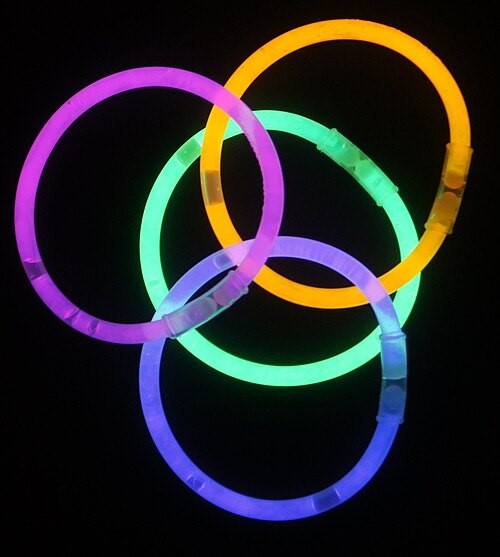
How do glow sticks work? Glow sticks work because some chemical reactions can produce photons of light. The process is called chemiluminescence and several animals and insects use it to produce light.
You can buy glow sticks from a lot of stores and they are not very expensive. They are usually a tube that is about fifteen centimeters long, although you can get a whole range of colors. You have to hold the tube in two hands and snap it. Once you do that, the glow stick will produce light for several hours. You can buy glow sticks that produce a variety of different colored lights. So, how do they work?
The glow stick is made up of two tubes. The outside tube is made of plastic and is flexible. It can be easily bent without breaking or bursting. Inside the tube is a second tube that is made of glass. The outer tube contains a chemical that doesn’t produce any light and the inner glass tube contains a chemical that doesn’t produce any light. When you snap the tube, the glass inner tube breaks and the chemical it holds mixes with the outer chemical. This is the reaction that produces the light. The outer tube also contains some kind of dye, which is what produces the different colors.
The chemical inside the inner glass tube is called hydrogen peroxide. You might have heard of hydrogen peroxide before. It comes in hair dyes, amongst other things, and is where the expression “peroxide blonde” comes from. It is a common bleach and is used to bleach paper as well as being used as household bleach. It is also found in disinfectants that are used to clean cuts and scrapes. It is a very powerful oxidizing agent. The chemical inside the outer tube is called diphenyl oxalate.
When you snap the tube and break the glass vial, the hydrogen peroxide mixes with the diphenyl oxalate. The hydrogen peroxide oxidizes the diphenyl oxalate. There are two types of oxidization. The one kind is with a solid, such as iron. The oxygen takes hydrogen away from the iron, causing it to rust. The second type of oxidization is chemical and that is the type we have here. The one chemical takes electrons away from the other chemical. The hydrogen peroxide and diphenyl oxalate go through several changes until they produce 1,2-dioxetanedione, which is a very unstable compound. It decays very quickly into carbon dioxide and when it does it releases energy. That energy would just dissipate if it wasn’t for the dye in the tube. The different colors of dye absorb the energy from the chemical reaction and that excites their electrons. The electrons jump up to a higher orbit. Electrons don’t like having more energy than they should, though, and they want to lose it as quickly as possible so that they can return to their original orbits. They lose the extra energy as a light photon. Different color dyes put out different wavelengths of energy, which becomes their color. The chemical reaction will keep going, producing more light, until all of the chemicals have changed state. You can speed up or slow down the reaction by heating or cooling the glow stick. If you heat it, you put in more energy and the chemical reaction happens more quickly, producing a brighter glow. If you chill it, the chemical reaction slows down and you get a duller glow, but it will last for longer.
There is one small problem with glow sticks and that is they can be harmful if they are cut open. The chemical reaction between the two chemicals produces something called phenol as a byproduct. Phenol can irritate the skin and cause inflammation.
The process behind glowsticks was invented by a scientist called Edwin A. Chandross. He was trying to work out why fireflies glowed and how they could produce light without heat. He experimented with several different chemicals and worked out the most effective combination. However, he wasn’t trying to make a glow stick. The first patents for an early glow stick were brought out in 1973. They weren’t as bright as they are today and were fairly expensive. Since then, they have dropped in price and they are most commonly made in China. And this is what I learned today.
Sources
https://www.glowtopia.co.uk/news/history-of-glowsticks/
https://en.wikipedia.org/wiki/Glow_stick
https://science.howstuffworks.com/innovation/everyday-innovations/light-stick.htm
https://pubsapp.acs.org/cen/whatstuff/stuff/7703scit4.html?
https://cen.acs.org/business/consumer-products/glow-sticks-s-chemical-reaction/99/i39
https://www.compoundchem.com/2014/10/14/glowsticks/amp
https://www.compoundchem.com/2014/09/30/hydrogenperoxide
https://dictionary.cambridge.org/dictionary/english/oxidize
image’ By domdomegg – Own work, CC BY 4.0, https://commons.wikimedia.org/w/index.php?curid=46035244
